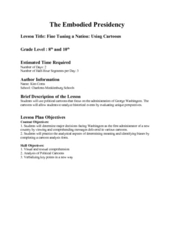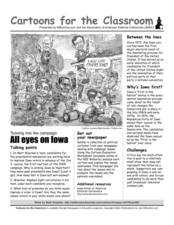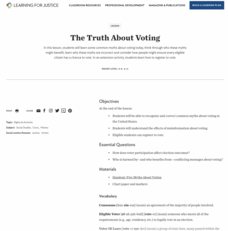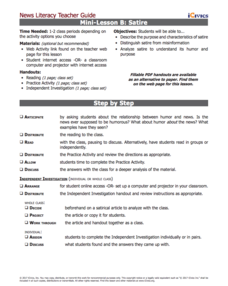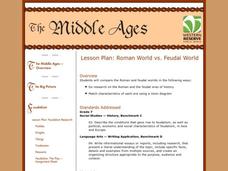Curated OER
Using a Political Map
In this online interactive map activity worksheet, students examine a political map of New Jersey and respond to 9 fill in the blank questions.
Curated OER
Worksheet for Analysis of a Political Cartoon
In this primary source analysis worksheet, students respond to 25 short answer questions that require them to analyze the political cartoon titled "America When Feminized."
Curated OER
Dr. Seuss Political Cartoon Questions
In this primary source analysis worksheet, students examine a political cartoon by Dr. Seuss about World War II and then respond to 5 short answer questions.
Curated OER
Fine Tuning a Nation: Using Cartoons
Students examine political cartoons to gain an understanding of the political issues that George Washington faced. In this historical perspectives instructional activity, students analyze political cartoons about the National Bank, the...
Curated OER
Technology and the Media
Students are introduced to the roles and influence of technology and the media on American representative democracy. They examine the effects of the Internet on citizens' role in government and the role and effects of media on the...
Curated OER
Cartoons for the Classroom: All Eyes on the Iowa Caucus
Explore the primary elections through political cartoons. Three talking points guide deeper thinking as pupils analyze a cartoon, which depicts the 2008 campaigning in Iowa. Analysts identify caricatures, research why winning Iowa is...
Curated OER
Wilson's 14 Points
Young scholars analyze political cartoons representing the role of the U.S. in the Post-World War One Era. They work in groups and analyze cartoons for their stereotypes, symbols, and caricatures. After analyzing them, they complete a...
Curated OER
Energy Crisis: Then and Now
Using political cartoons, scholars analyze the energy crisis of the 1970s and '80s, comparing and contrasting it to current tensions with oil. Display the 6 cartoons (linked) to the class, and demonstrate analysis using the worksheet...
Curated OER
Covering the Issue
Examine how art and music can be powerful tools for conveying a political or social message. After considering the issues surrounding rapper Paris, students design their own album covers that reflect their political and/or social...
Curated OER
Colonial North America
Showcase the religion, conflicts, daily life, and politics of Colonial North America. A very well-done presentation highlights all the major colonial groups, social norms, demographics, and political struggles of the time. Perfect for an...
Curated OER
Fossil Fuels (Part I), The Geology of Oil
Junior geologists work through three mini-lessons that familiarize them with the formation and location of fossil fuels. Part one involves reading about petroleum and where it comes from via a thorough set of handouts. A lab activity...
C-SPAN
Evaluating Historical Presidential Campaign Ads
Political ads flood the airwaves each election cycle. An activity including more than a dozen political ads from iconic presidential campaigns helps learners unpack how the sausage gets made during election "silly season." Using the...
Museum of the Moving Image
AdMaker, Obama vs. McCain, “Fundamentals” (2008)
Truth is often left on the cutting room floor when political ads are produced. After viewing the 2012 backfire ad, "Fundamentals" that takes John McCain's comments on the US economy out of context, class groups edit the audio and video...
Constitutional Rights Foundation
Purged From the Voter Rolls: Husted v. A. Philip Randolph Institute
Once a registered voter isn't always a registered voter. Academics explore the topic of voter registration and hindrances to remaining registered. The resource focuses on data analysis, federal voter registration law, and Supreme Court...
Teaching Tolerance
The Truth About Voting
True or False: Only Presidential elections matter. Academics delve into common voting myths to understand what is true and why the election process is critical to democracy. The lesson uses group discussion, activities, and handouts to...
Constitutional Rights Foundation
Why Don’t More People in the U.S. Vote?
To vote or not to vote, that is the question. Secondary scholars explore voter turnout in the United States. The resource uses informational text, group discussion, and a worksheet to help academics understand hindrances to voting and...
Curated OER
Election of 1864
An interesting lesson plan uses a hands-on-activity and group discussion to explore the 1864 presidential election and Lincoln's plans for ending the Civil War. Designed for high school, the resource also requires historians to...
Curated OER
Teacher Notes
Gathering information, distinguishing between arguments, preparing an oral presentation; these skills are fostered as 10th graders explore aspects of global trade and politics. They use the Internet to gather information about NATO, The...
National Endowment for the Humanities
Lesson 1: The United States Confronts Great Britain, 1793–1796
After the Revolutionary War, the success of the United States was far from guaranteed. Foreign powers coveted the new land, and Great Britain challenged American sovereignty. Learners consider the challenges facing the new nation using...
iCivics
Mini-Lesson B: Satire
Hey, what's so funny? Explore the use of satire in a variety of media with a hands-on instructional activity. Fourth in a five-part journalism series from iCivics, the activity introduces satirical language in print and online. Pupils...
College Board
2015 AP® Human Geography Free-Response Questions
How are population and political power related? What is the significance of the globalization of English? Why do refugees leave their home countries? Using structured short-answer questions, scholars unravel complicated dynamics with...
Northeastern Educational Television of Ohio, Inc.
Roman World vs. Feudal World
Young historians compare the major features of the Roman and feudal worlds, such as religion, social hierarchy, and political tenets, using online resources and group discussion.
Mikva Challenge
Deconstructing Campaign Messages and Perceptions
Target audience, covert message, explicit and implicit appeals. As part of an investigation of rhetorical devices used in campaign ads, class members examine and deconstruct the appeals in logos from the 2008 election. They then use the...
Advocates for Human Rights
The Rights of Women in the United States
Six diverse activities make up a substantial unit on the women's rights movement in the United States, past and present. A few of the topics at hand: the fourteenth and nineteenth amendments, the Equal Pay Act, the Lily Ledbetter Act,...





